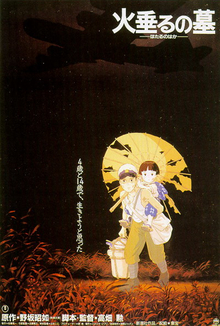Though not explicitly anti-war, the studio’s more harrowing films advocate for hope and nonviolence when highlighting the devastation of human conflict
By SUN YIE — arts@theaggie.org
Animation plays a pivotal role both in shaping people’s experiences and in delivering deeper and more thought-provoking messages where other forms of media fall flat in comparison. Studio Ghibli’s “Grave of the Fireflies” (1988), directed by Isao Takahata, is an example of a successful animation film that explores scenes of hardship, war and loss under the setting of World War II, denoting the company’s broader anti-war sentiments that are also present in their films “Castle in the Sky” (1986) and “Princess Mononoke” (1997).
“Grave of the Fireflies” follows two Japanese siblings who struggle to survive in the midst of a war; although this alone is harrowing enough, the opening scene of the film depicts a dying Seita, who elaborates upon their story in the structure of episodic flashbacks. “Castle in the Sky” positions itself against the introduction of atomic power, as the film also occurs in the historical context of World War II and the bombings of Hiroshima and Nagasaki, while “Princess Mononoke” explores the shifting role of nature in relation to human settlement and innovation. “Princess Mononoke” possesses rather meticulous, nuanced ideas about war and is more a critical analysis about the boundaries between nature and human exploitation and destruction. Contrastingly, both “Grave of the Fireflies” and “Castle in the Sky” adopt a more translucent position against war through the lens of their characters.
Takahata explained he doesn’t consider “Grave of the Fireflies” to be an “anti-war film,” because he felt it didn’t incentivize people against war or contribute to world peace. However, it can be said that the film’s depiction of the impact war has on innocent civilians, such as the scene where fishermen are forced to watch the city of Kobe be consumed by flames, is impactful enough for people to adopt a more humanistic and empathetic perspective — which leads them away from violent pursuits. In fact, Takahata leaves room for hope in the face of hopeless loss and devastation through his poignant use of fireflies, which can be recognized as symbols of both the fire bombs that have destroyed the civilians’ homes and human perserverance.
In its production of “Grave of the Fireflies” and “Castle in the Sky,” Studio Ghibli juxtaposes the conventional use of animation — often associated with children and thus considered to be more lighthearted — with heavier tones. In doing so, Studio Ghibli exhibits mastery over the art form of animation entirely, as it demonstrates the capacity to appeal to children through its more joyful films, like “My Neighbor Totoro” (1988), and yet address more haunting topics like war, violence and exploitation to audiences of all ages in “Grave of Fireflies” and “Castle in the Sky.”
Written by: Sun Yie — arts@theaggie.org




